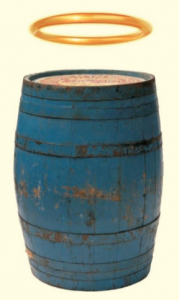
“BBL” means blue barrel – which is 42 U.S. gallons. It is the oil and gas industry’s standard measure for production and sales of crude oil and oil products (e.g., refined gasoline and diesel, jet fuel, distillates).
Various competing theories fight over the meaning of “blue” in the BBL acronym. Why the color blue and not black or brown? Some theories trace to commercial practices in old England or colonial America – times that well pre-date the oil and gas industry’s birth.
Oil and gas folks gravitate towards the theory that places the BBL acronym with the industry’s very birth in Pennsylvania, under the powerful and controlling hands of John D. Rockefeller. The theory goes as follows:
John D. Rockefeller’s Standard Oil stabilized the world’s first crude oil market in the 1870s by rigidly defining the commercial buy-sell unit as a barrel containing exactly 42 U.S. gallons, no more and no less. Rockefeller painted his company’s barrels dark blue to distinguish them from the barrels of unscrupulous oil buyers, who frequently played fast and loose with proper oil measurement. Standard Oil and, to this day, the companies descending from it like ExxonMobil and Chevron have used dark blue in their corporate logos to honor the Blue Barrel’s legacy. The BBL remains the key production and commercial measurement for crude oil activities all over the world, including the payment of oil royalties and working-interest entitlements.
Related to BBL is the acronym “BOE” – a barrel of oil equivalent. Used usually to state gas reserves on an oil basis, the BOE metric converts gas MMBTU value to a hypothetical oil BBL. Put differently, even though the hydrocarbon would exist in a gaseous state at the surface of the earth, the BOE metric pretends it would exist in liquid (crude oil) form. The quality of the gas – specifically, its potential liquids content – determines the mathematical formula for converting gaseous MCFs or MMBTUs to BBLs. However, a commonly used formula simply divides an MCF by six to result in a BOE equivalent. For example, a company holding on 30 trillion cubic feet of gas (i.e., 30 billion MCFs of gas) in proved reserves – like Total S.A. – would be considered to hold five billion BOEs. Take 30 billion MCFs of gas and divide it by the number six (6).
Holmes PLLC has a handle on the metrics necessary to understand and monitor the gas-based and liquid-based payments to its clients in the upstream markets.
